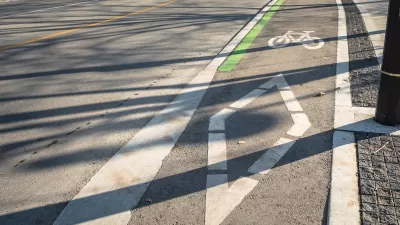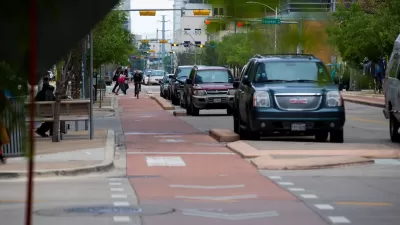Cities around the United States have built nearly as many protected bike lanes in the past two years as they did in the previous 140.

The Green Lane Project released an updated inventory of protected bike lanes around the country, noting the quick rate of adoption for the most robust form of bike infrastructure. "Between 1874 and 2011, only 78 of these facilities were built nationwide. Our inventory shows that this number nearly doubled to 138 protected bike lanes witin [sic] the first two years of the Green Lane Project. 60 percent of the new lanes were in the Green Lane Project's six founding focus cities: Austin (6), Chicago (17), Memphis (1), Portland (2), San Francisco (9) and Washington DC (2). By the end of 2014, 191 protected lanes were on the ground across the country."
The main purpose of the post is to share an updated inventory of current protected bike lanes in North America, which is available in Google Drive as well as for download, but the Green Lane project has also prepared the video below to explain the differences between protected bike lanes and other forms of bike infrastructure.
FULL STORY: Inventory of Protected Bike Lanes

Americans May Be Stuck — But Why?
Americans are moving a lot less than they once did, and that is a problem. While Yoni Applebaum, in his highly-publicized article Stuck, gets the reasons badly wrong, it's still important to ask: why are we moving so much less than before?

Using Old Oil and Gas Wells for Green Energy Storage
Penn State researchers have found that repurposing abandoned oil and gas wells for geothermal-assisted compressed-air energy storage can boost efficiency, reduce environmental risks, and support clean energy and job transitions.

Placekeeping: Setting a New Precedent for City Planners
How a preservation-based approach to redevelopment and urban design can prevent displacement and honor legacy communities.

Study: Maui’s Plan to Convert Vacation Rentals to Long-Term Housing Could Cause Nearly $1 Billion Economic Loss
The plan would reduce visitor accommodation by 25,% resulting in 1,900 jobs lost.

Idaho Data: Unexpected Vehicle Repairs Exacerbate Housing Instability, Eviction Risk
Over 21 percent of clients struggle with transportation barriers.

A Year-Long Investigation On Permanent Supportive Housing
The New York Times reveals what’s working and what’s not in the cornerstone of Housing First.
Urban Design for Planners 1: Software Tools
This six-course series explores essential urban design concepts using open source software and equips planners with the tools they need to participate fully in the urban design process.
Planning for Universal Design
Learn the tools for implementing Universal Design in planning regulations.
Heyer Gruel & Associates PA
City of Moreno Valley
Institute for Housing and Urban Development Studies (IHS)
City of Grandview
Harvard GSD Executive Education
Salt Lake City
NYU Wagner Graduate School of Public Service
City of Cambridge, Maryland





























